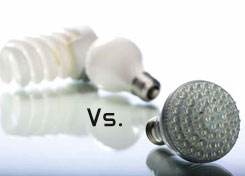 Going green always helps, no matter which part of the world you belong to, which business are you into. With ever increasing energy demands of our modern houses, EnergyStar recommends new smarter Green homes that by its inherent design reduce the amount of energy needed with the help of Proper Air Sealing & Insulation, reducing the induction. Same applies to cars, we need more EVs.
Going green always helps, no matter which part of the world you belong to, which business are you into. With ever increasing energy demands of our modern houses, EnergyStar recommends new smarter Green homes that by its inherent design reduce the amount of energy needed with the help of Proper Air Sealing & Insulation, reducing the induction. Same applies to cars, we need more EVs.
Second biggest source of Energy consumption is the Lighting. We can chose LED light bulbs to illuminate Home and workplaces, effectively saving as large as 90% of the Energy spent by traditional Incandescent tubes/bulbs. Earlier, CFLs were considered as an effective replacement, but with advent of White LEDs, much higher efficiencies have been attained.
Philips, LG,and other leading electricals have started bringing great LED lamps to the market. A single 5 watt LED bulb would easily outperform a 25watt CFL and that too with a pure white light.
LED vs. CFL vs. Incandescent Energy efficiency
The reason is obvious, LED is the most effiecient since it completes almost all of the electrical energy into Light and very minimal amount of energy is dissipated. However a traditional light bulb spends more energy in heating than emitting light.
Going by approximate figures a 60 watts Incansescent = 20 watts CFL = 3.5 watts LED
Lifetime
The lifetime of an LED bulb is nearly 50, 000 hours (~6 years), when run continously. Which is insanely great as compared to 8,000 hours of CFLs and 1200 hours of Incandescent bulbs.
Directional
Unlike other sources, LEDs tend to be directional due to their inherent design. However, newer designs with multiple LEDs aligned at different angles into a same bulb, make it possible to cover a wider area.
Time to Reach maximum Light
LEDs are instantaneous, taking only nano seconds. Incandescent takes order of 2-5 seconds. CFLs are slowest, taking upto 30 seconds to emit maximum lumens of energy.
Environmental friendliness
- Toxic material: LEDs and CFLs are both environmental friendly as they donot have mercury.
- Carbondioxide Emissions: Lower energy consumption decreases CO2 emissions and hence LEDs do 451 pounds/year, CFLs 1051 pounds/year, and Incandescent does 4500 pounds/year.
Drawbacks:
LEDs: They are realtive expensive today, but should get cheaper as cost of production is low. Another disadvantage is that its almost impossible to find High power LED bulbs. I haven’t seen many options above 10watts.
CFLs: They are not as efficient and take alot of time to reach full power.
Incandescent: Everything about them is actually a disadvantage.
Comparison of Real world performance:
Here is a comparison of LED against CFLs, Incandescent light sources:
Here’s a Philips LED:
another comaprison:
For latest iPhone, Google, Open Source, Android, Tech news @taranfx on Twitter or subscribe below:
loading...
loading...

CFL’s have rather large amounts of mercury, unlike incandescents that only feature trace amounts
loading...
loading...
CFL’s have lots of mercury, correction
loading...
loading...
Incandescent lights use a tungsten filament with no mercury. CFLs have a small amount of mercury, (about 4mg); however, considering the number of bulbs out there that are not properly disposed of, that’s wuite a bit getting to the landfills. LED are DC and require a power adapter. Most DC power adapters are less than 50% efficient, so you night as well double the energy requirement for LEDs.
Over all, LEDs are still the best bet, or will be, once they get more houses wired for DC lighting.
loading...
loading...
what about the possible health related effects of CFL?
loading...
loading...